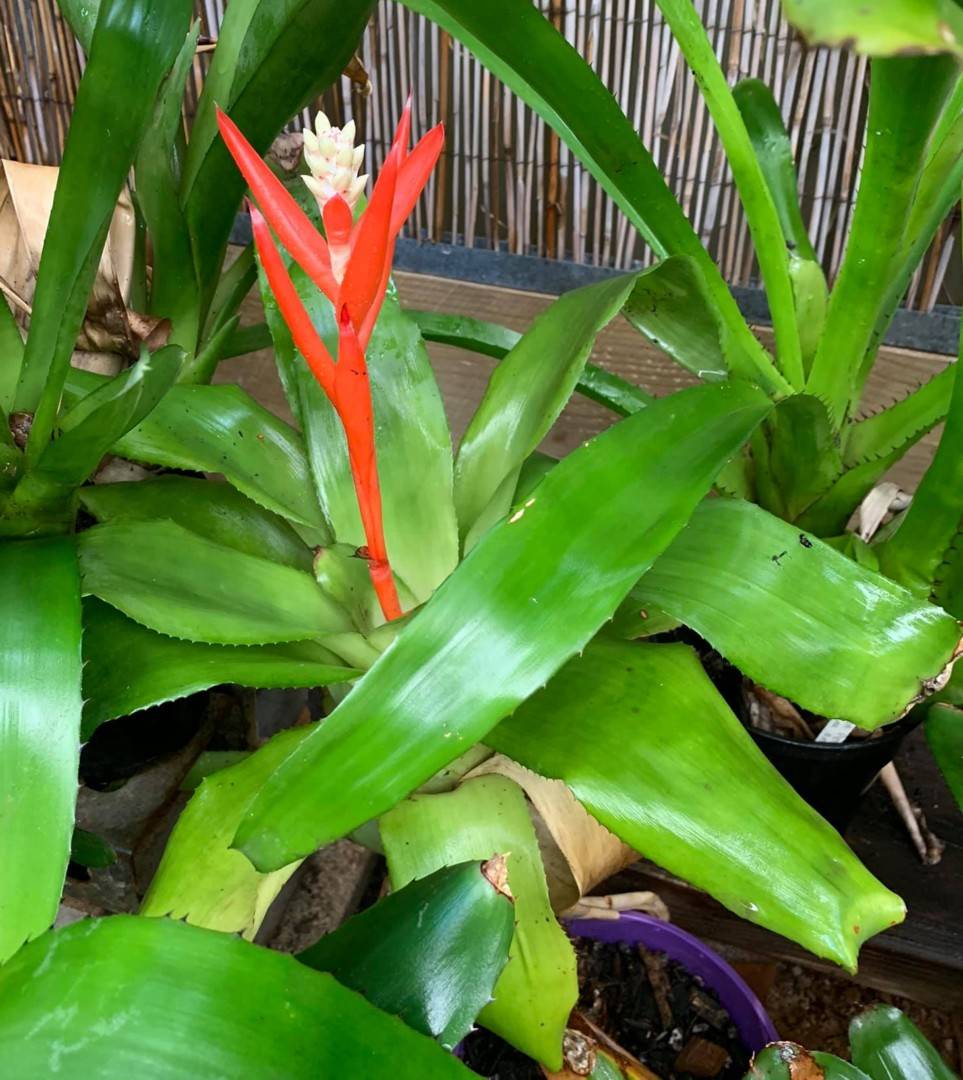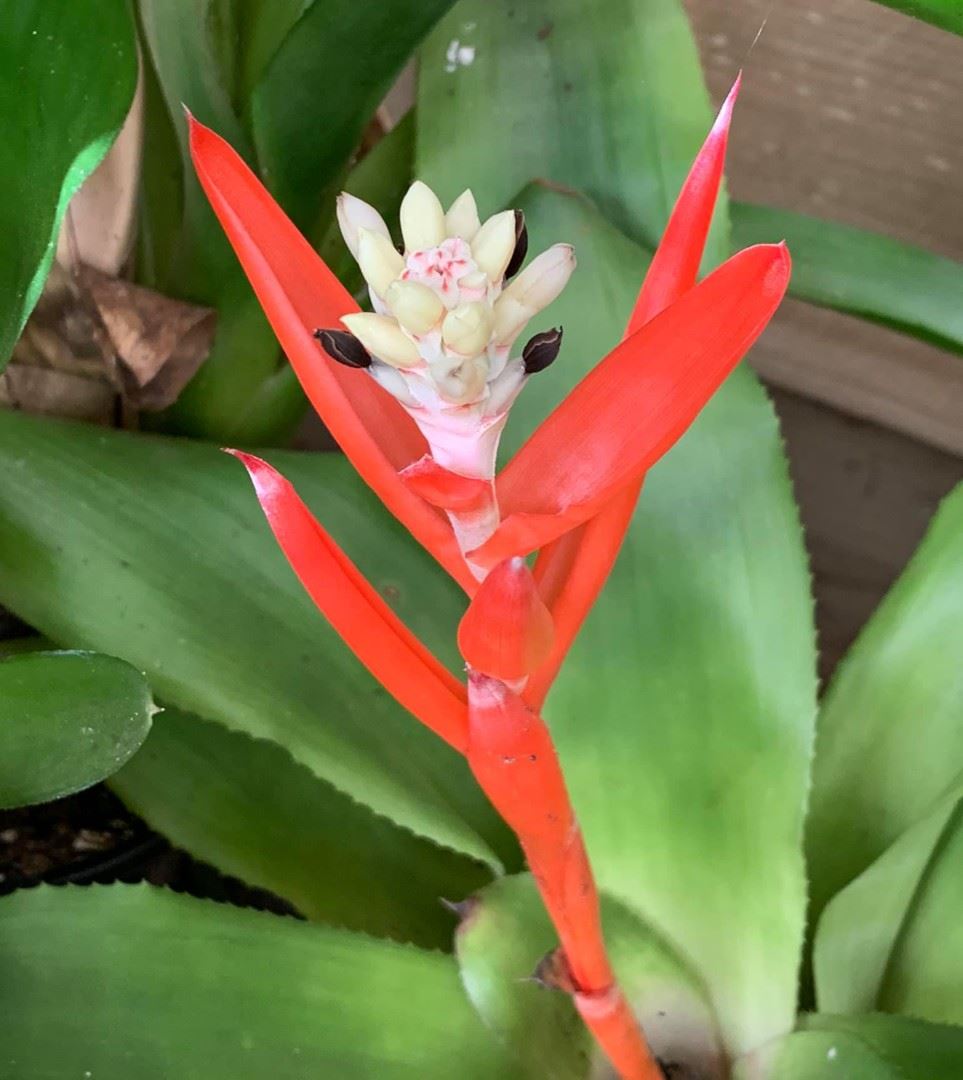



HERB epiphyte or terrestrial, 24.5-47.5 cm high.
ROSETTE funnelform or wide-funnelform, with 15-25 leaves.
LEAF SHEATHS 10-15x 4-9 cm, orbicular or elliptic, adaxial surface vinaceous, abaxial surface green.
LEAF BLADES 20-55x 2-5 cm, linear, concolorous green, apex obtuse or acute, apiculate, margins serrate; spines castaneous, 1-3 mm long.
INFLORESCENCE with spike 3-6 x 2-4 cm; peduncle green, 18.5-42 cm long, white floccose; peduncle bracts imbricate or subdense, divergent toward the apex of the peduncle, entire, red, 5.5-11 x 1.5-3 cm, apex acuminate.
FLOWERS 1.8 - 2.1 cm long.
FLORAL BRACTS 8-12 x 11-17 mm, depressed ovate, shorter than the sepals, coriaceous, white, green or yellow greenish with red apex and margins, white floccose or appressed lepidote, apex truncate, apiculate.
SEPALS 8-12 x 5-7 mm, distinctly asymmetric, connate near the base, white or white greenish, covered with white appressed scales, apex obtuse, muticous or minutely apiculate.
PETALS 14-17 x 4 mm, lingulate, white, apex obtuse, erect; fimbriate ligulae about halfway along the lateral folds.
STAMENS with filaments 12-15 mm long; anthers c. 5 mm long.
STIGMA c. 2 mm long. OVARY c. 4 mm long, bearing a short epigynous tube; ovules 0.5-1 mm long.
FRUIT greenish; seeds c. 4 mm long, pale brown.
Distribution and habitat: A. alba is almost restricted to the south of Bahia state, being recorded at lower frequency in boundary areas with Minas Gerais state (Fig. 4A). It grows at 5-700 m altitude, in herbaceous, shrubby and wooded restingas, dense ombrophile forest and florestas de tabuleiros.
Conservation status: Near Threatened (IUCN, 2001).
Notes: When Pereira & Moutinho (1980) described A. pabstii, they proposed an affinity with A. lamarchei, A. chlorophylla and A. triangularis. Even although the white corolla was considered relevant for the identification of this species, the authors disregarded the fact that the same character was found in A. alba, described almost 90 years earlier (Mez, 1891-94) for the same region of A. pabstii. The fact that A. alba was described as having petiolate leaves and that this feature was stressed by Smith & Downs (1979) in the taxonomic treatment of the subgenus, could explain why, until now, A. alba and A. pabstii were considered distinct species. We did not detect, however, the presence of petiolate leaves in the holotype or isotype of A. alba or in other herbarium specimens examined in this study. The phenetic analyses suggested a close affinity between A. alba and A. pabstii. The comparision of type materials and original descriptions indicate that they should be treated as synonyms. Aechmea alba can be characterized by the coriaceous, depressed ovate and truncate-apiculate floral bracts (Fig. 3D) and, especially, by the white calyx and corolla (Fig. 10A, B). It resembles A. lamarchei and A. maasii in having leaf spines up to 3 mm long, obtuse and distinctly asymmetric sepals and obtuse, lingulate petals with fimbriate ligulae about halfway along the lateral folds (Fig. 3B, E, F). The species is well represented in herbaria, where most of the exemplars were previously erroneously identified as A. lamarchei or A. chlorophylla.
Aechmea alba Mez, Mart. Fl. Bras. 3(3): 375. 1892.
Desc from S&D
Leaves to over 1 m long, the outer distinctly petiolate (! Mez);
Sheaths subelliptic, large, sparsely appressed-lepidote;
Petioles elongate, 12-15 mm wide, channeled;
Outer blades linear-lanceolate and inner ligulate and not at all contracted, both rounded and apiculate, to 33 mm wide, laxly serrulate with spines 0.5 mm long, green, subglabrous.
Scape slender, subglabrous;
Scape-bracts erect, densely imbricate, subelliptic, acuminate, massed beneath the inflorescence.
Inflorescence pendulous, simple, very dense, 40 mm long, 18 mm in diameter, densely white-lanate.
Floral bracts suborbicuČlar, truncate and apiculate, enfolding the flowers, bearing a thick central keel;
Flowers sessile, 19 mm long.
Sepals free, strongly asymmetric, truncate and minutely mucroČnate, 8 mm long, subglabrous;
Petals acute, 15 mm long, white, soon darkening, bearČing 2 fimbriate scales;
Stamens included;
Ovary sub cylindric.
Type. Blanchet 2276 (holotype, G; photo F 8480), without exact locality, Bahia, Brazil, 1834.
Distribution. Bahia and Rio de Janeiro, Brazil.
BRAZIL. Rio de Janeiro: Esperanca, Riedel s n (LE n v! Mez).
Note. Not having seen the Riedel specimen it is suspected from the description of leaf-blades that there may be a mixture of two species under this name.
Aechmea pabstii Pereira & Moutinho, Bradea 3: 86-7, 91, 95. 1980
Terrestris usque 70cm alta. Folia circa 12, omnia similia, rosulata, ligulata, 36-65cm longa, utriculum infundibuliformem efficientia; vagina elliptica, 13-15cm longa, 7-9cm lata, utrinque dense et adpresse brunneo-lepidota, margine quarta parte superiore minute et dense spinosa; limbo lineari, 20-40cm longo, 3-5cm lato, exterius dense, interius inconspicue albo-lepidoto, margine minute spinosa, spinis haud ultra 1 mm longis, ca. 8 mm inter se distantibus, apice rotundato, recurvato et mucrone tenue aucto. Scapus erectus, 35-40cm altus, 5mm crassus, albo-lepidotus, internodiis ca.10, inferioribus 6cm longis, superioribus sensim brevioribus; bracteis scapalibus inferioribus totaliter amplectentibus, in apicem versus margine minute serrulata, 6cm longis, 3cm latis, superioribus patentibus usque ad divaricata, late lanceolata, in apicem scapi versus ovatis cum acumine rigidiusculo, prope inflorescentiam valde aggregatis, 6-9cm longis, 2-3cm latis. Inflorescentia erecta, simplicissina, strobiliformis, cylindrica 4-8cm longa, 2-3cm diamet.; bracteis florigeris suborbicularibus, concavis, roseis, lepidibus albis obtectis, apice truncato et apiculato, dorso tricarinato et gibboso, 8mm diamet., ovarium aequantibus et involventibus sed haud in totum. Flores subsessiles 20mm longi; Sepalis asymetris, ovalibus, 12mm longis, 5mm latis, 4 mm alte connatis, apice nullo modo mucronato, albescentibus, exterius lepidibus albis obtectis; petalis spathulatis, acutis, 17mm longis, albis, demum nigrescentibus, prope basim ligulis binis, fimbriatis auctis; staminibus 12mm longis, filamentis complanatis, antheris 5mm longis, linearibus, base obtusa et leviter sagittata, apice apiculato; ovario 5mm longo, subcylindrico; tubo epigyno lmm longo; placentis apice loculis affixis; ovulis longe caudatis.
TYPUS: Estado da Bahia, Porto Seguro, Estrada para Arraial de N. S. da Ajuda: Leg. J.L.Moutinho no 59, 5.Fev.1980. Holotypus HB 70.668, Paratypus HB 70.669.
Pelo habito da plants assemelha-se a A. lamarchei Mez e A. chlorophylla L.B.Sm., das quais difere pela forma das bracteas florais e pela cor da corola; e afim de A. kautskyana Pereira & Smith, diferindo desta pela cor da corola e pela forma das folhas.
Plant terrestrial up to 70cm high.
Leaves about 12, all similar, rosulaČte, ligulate, 36-65cm long, forming a funnel shaped utriculum;
Sheaths elliptic, 13-15cm long, 7-9cm wide, both sides dense and adpressed brown lepidote, edges in the upper quarter minute and dense spined;
Blades linear, 20-40cm long, 3-5cm wide, outside dense, inside inconspicuous white lepidote, edges minute spined, spines hardly more than 1 mm long, ca. 8 mm apart, tip rounded, recurved and a tenuous mucro.
Scape erect, 35-40cm high, 5mm thick, white lepidote, internodes ca.10, lower ones 6cm long, upper ones gradually shorter;
Scape bracts lower ones totally enclsing the scape, towards the top minute serrulate, 6cm long, 3cm wide, upper ones spreading to divaricate, wide lanceolate, to the top of the scape ovate with acuminate becoming rigid, clustering near the inflorescence, 6-9cm long, 2-3cm wide.
Inflorescence erect, simple, strobiliform, cylindric 4-8cm long, 2-3cm diam.;
Floral bracts suborbicular, concave, pink, white lepidote, tip blunt and apiculate, back three keeled and gibbose, 8mm diam, equalling the ovary and enclosing it but never totally.
Flowers subsessile 20mm long;
Sepals asymmetric, ovate, 12mm long, 5mm wide, connate for 4 mm, yet by no means mucronate, whitish, outside white lepidote;
Petals spathulate, acute, 17mm long, white, later becoming blackish, near the base 2 fimbriate ligules;
Stamens 12mm long, filaments complanate, anthers 5mm long, linear, base obtuse and lightly sagittate, tip apiculate;
Ovary 5mm long, subcylindric; epigynous tube lmm long; placenta joined to the top of the locules; ovules long caudate.
Related to A. lamarcheii Mez and A. chlorophylla L.B.Sm., this new species is readily distinguished by the shape of the floral bract and the color of the corolla. It is also close to A. kautskyana Pereira & Smith, from which it differs in the color of the corolla and in the shape of the leaves.